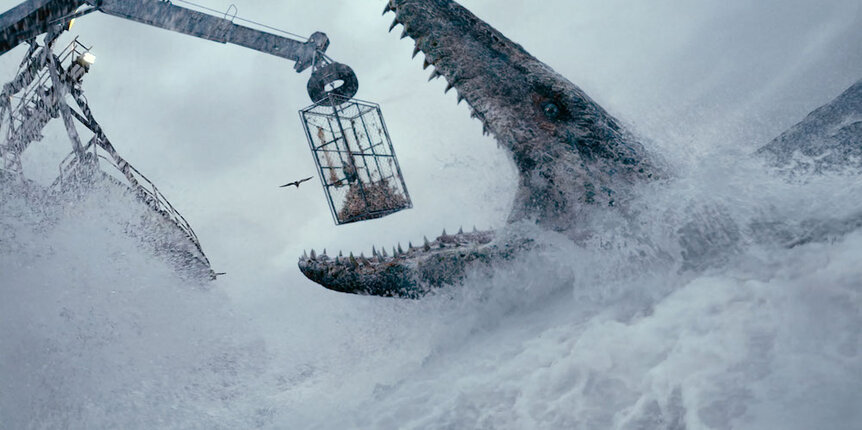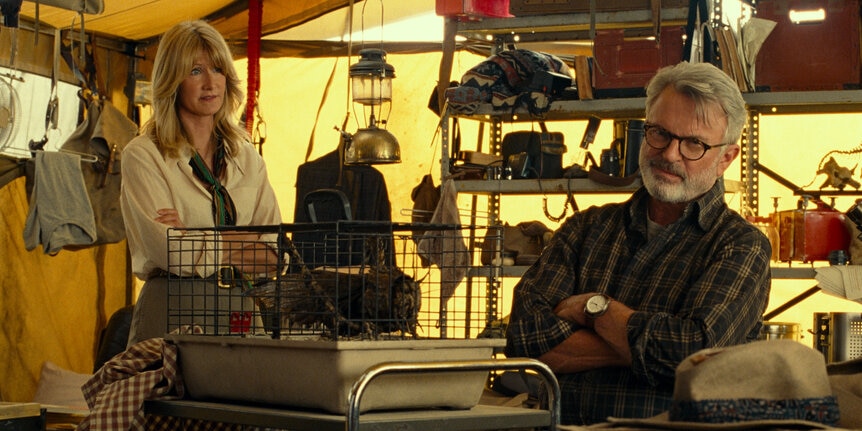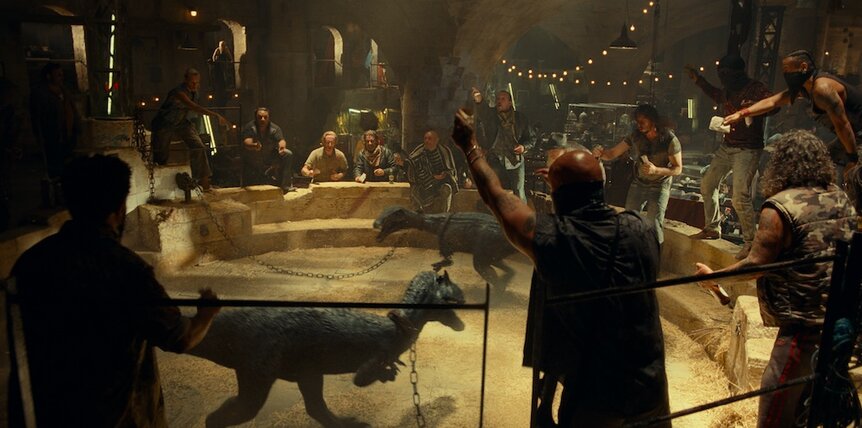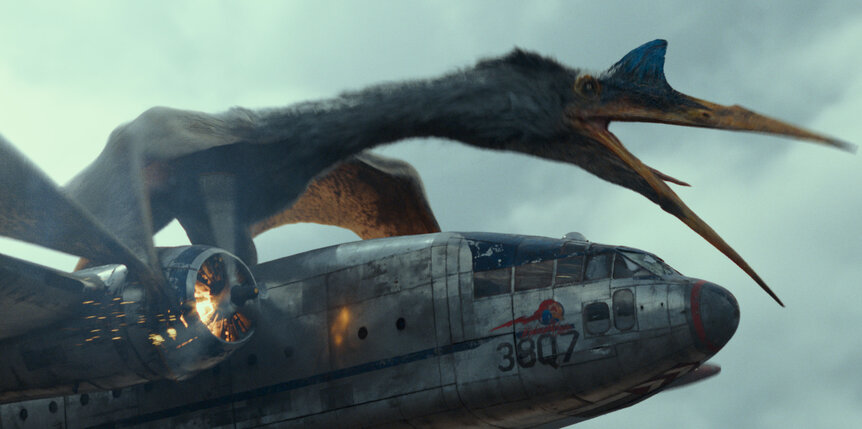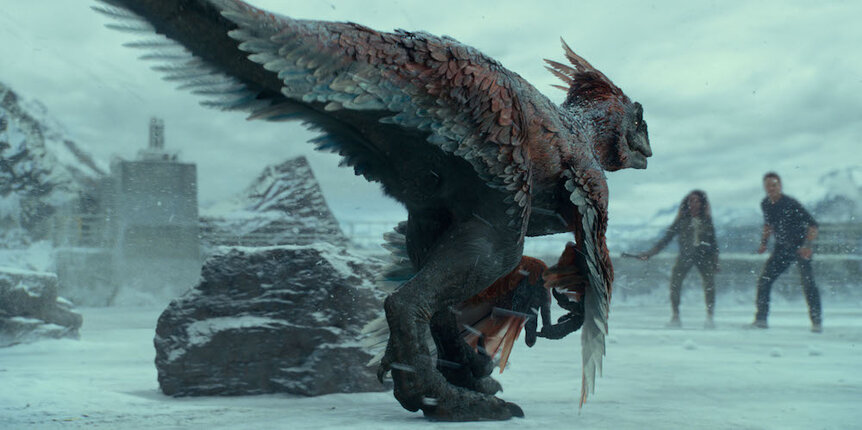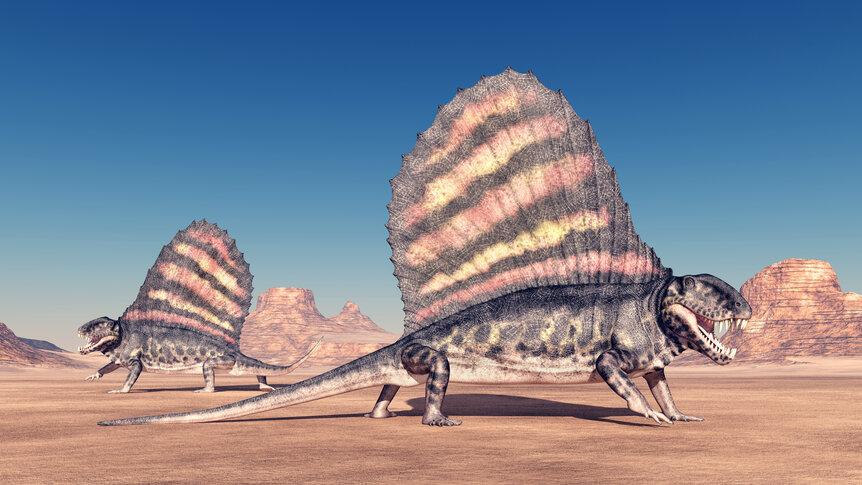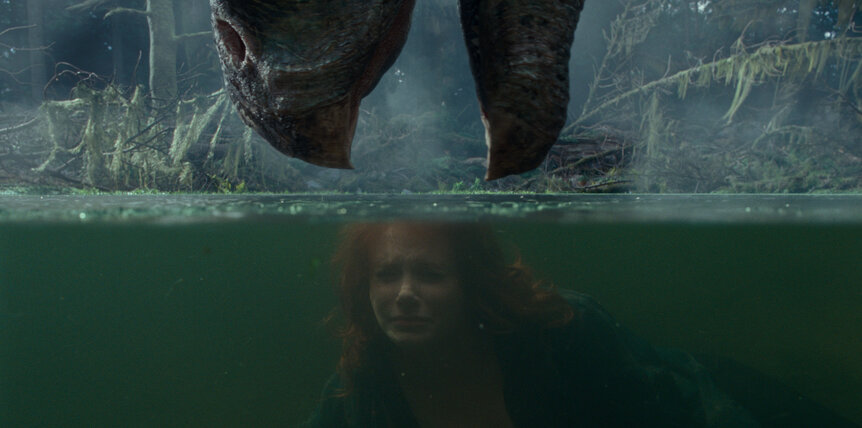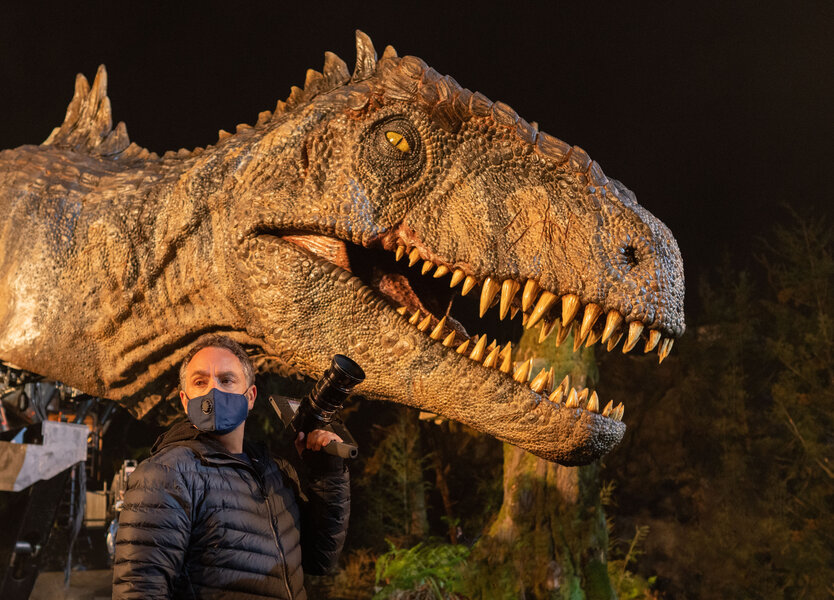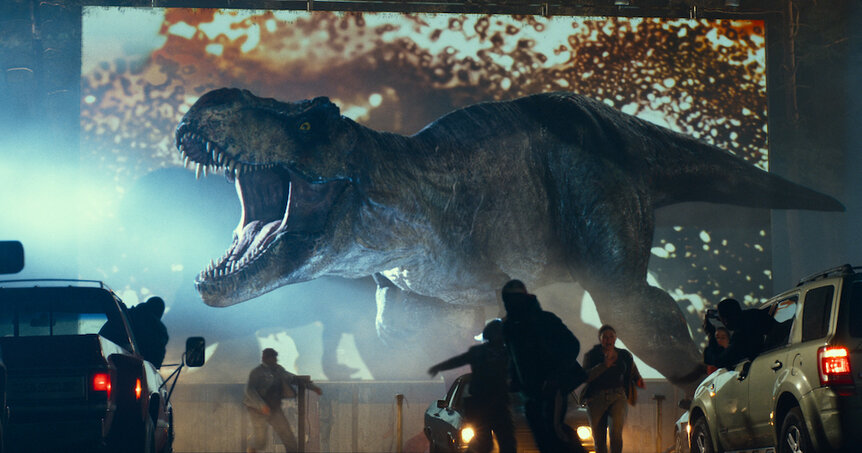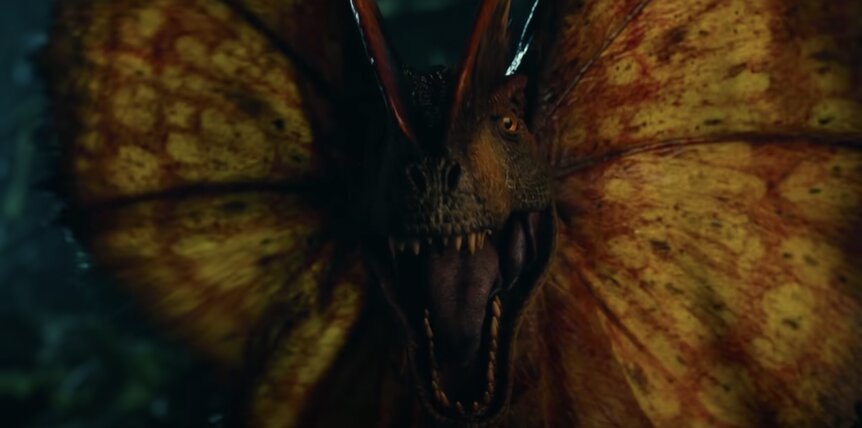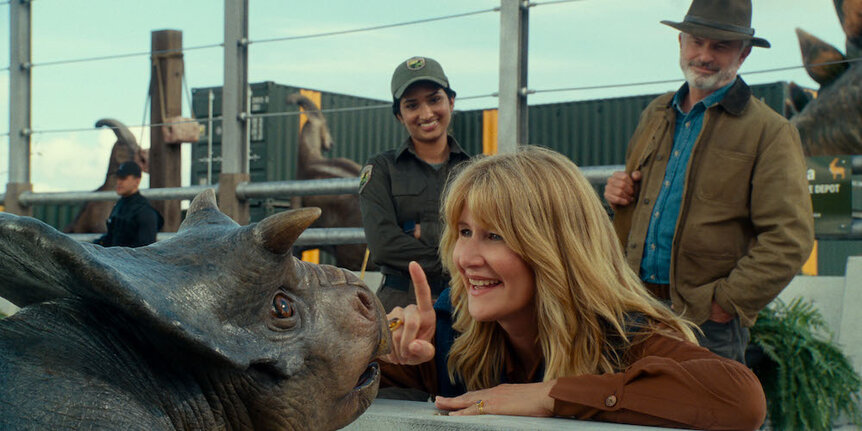Create a free profile to get unlimited access to exclusive videos, sweepstakes, and more!
From killer dinosaurs to giant locusts: A guide to the CG and practical creatures of 'Jurassic World Dominion'
The locust animatronic was so real that director Colin Trevorrow was able to feed it a Dorito.
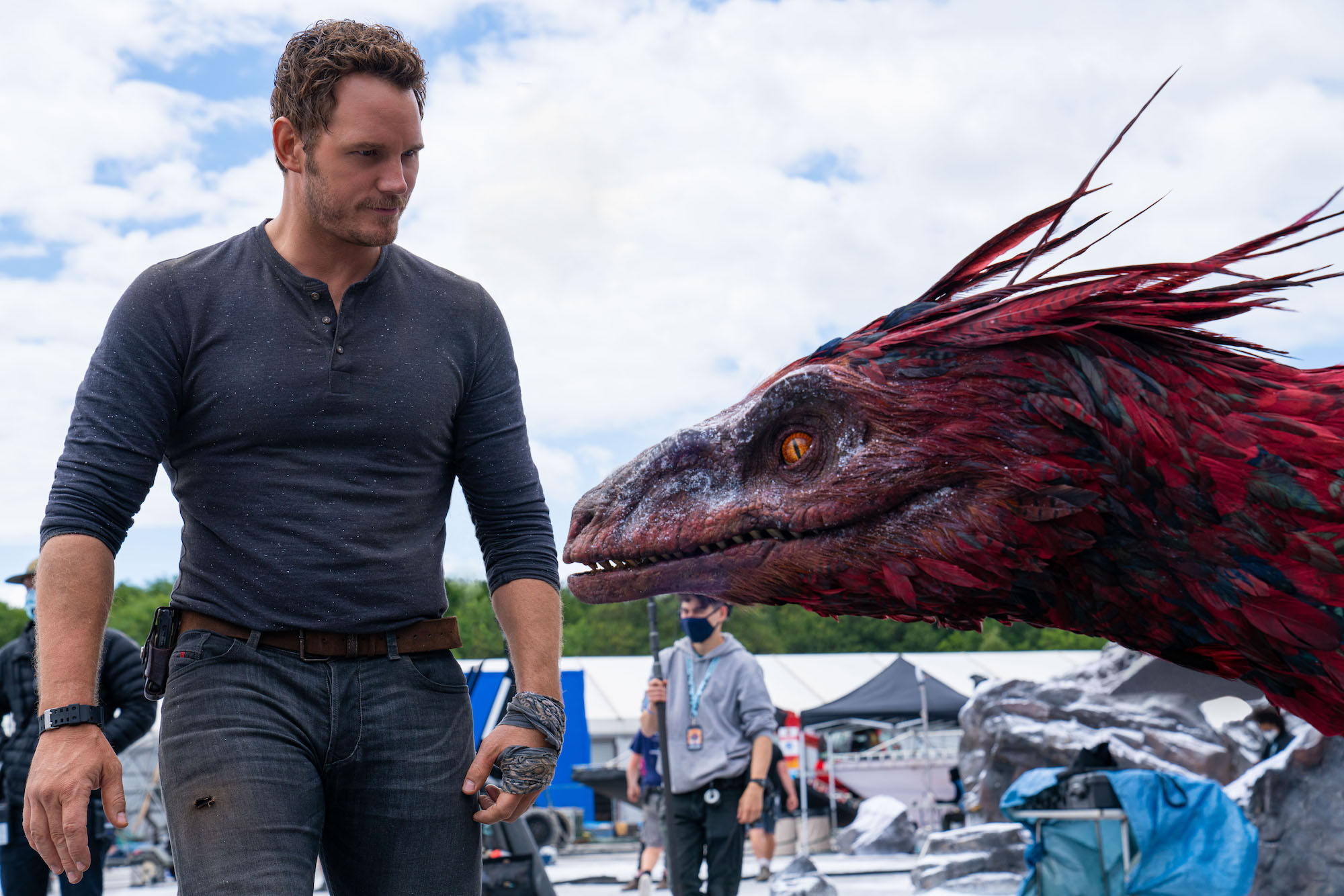
You'd think that "Go big or go home" would be the guiding philosophy behind Jurassic World Dominion, but you'd be wrong. Yes, writer/director/producer Colin Trevorrow wanted the swan song to his dino-trilogy to pack in the larger-than-life blockbuster thrills fans have come to expect from the 30-year-old franchise. That really goes without saying. At the same time, however, the filmmaker also wanted finesse, elegance, and restraint.
"It's always tricky when you're working on a sequel to a feature because the temptation is to be bigger, and bolder and better and louder and brighter," the movie's VFX Supervisor and ILM veteran, David Vickery, tells SYFY WIRE. "How do you turn the dial up? The beautiful thing about Jurassic World Dominion is we had a different angle, so we didn't necessarily have to go bigger and bolder and brighter. This is the first time when dinosaurs were actually let loose in the world and we get the chance to see how they interact with all these different scenarios like an Apatosaurus at a lumber mill; or a Stygimoloch on the side of a railway; or what happens when a Mososaur meets a crab boat?"
Leaning into the grand traditions of the Jurassic film series that the legendary Steven Spielberg first made so iconic, Trevorrow never failed to encourage the construction and utilization of practical puppets and animatronics for the prehistoric creatures run amok. The marriage of in-camera effects and cutting-edge CGI felt more appropriate than ever on this project, given the fact that Dominion would bridge the gap between old and new by having our contemporary heroes — Owen Grady (Chris Pratt), Claire Dearing (Bryce Dallas Howard), and Maisie Lockwood (Isabella Sermon) — meet up with the OG Jurassic Park trio: Alan Grant (Sam Neill), Ellie Sattler (Laura Dern), and Ian Malcolm (Jeff Goldblum).
"You've got the two generations of characters in there as well, and then bringing back some fan favorites like the Dilophosaurus," says Live-Action Dinosaur Supervisor John Nolan. "[Then there's] ‘the new kid on the block,’ as Colin calls it, which is the Giga, which was the biggest dinosaur head [built for] any of the Jurassic films. So yeah, [it was] just mouth-watering, really, considering the last two Jurassic World films didn't have that many animatronics or in-camera effects involved, a lot of it was visual effects. It was so lovely that Colin put faith in us and allowed us to build so many [of them]."
Like InGen combining dinosaur DNA with the genetic material of frogs, Vickery and Nolan worked incredibly hard to marry their respective areas of expertise in a way that felt organic and inconspicuous to the naked eye. "We almost became one department with visual effects, creature effects, and special effects," Nolan explains. "Ultimately, we all want the same goal, which is believable, beautiful dinosaurs, and we need each other so that was a perfect way that all the disciplines really overlapped."
To that end, Dominion's chief visual effects wizards were kind enough to walk us through the creative processes for almost every prehistoric beast that appears in the film...
Mosasaur
Dominion opens with a montage that shows how dinosaurs have become an everyday inconvenience for our world — both on land and at sea. Interestingly, the Mososaur's attack on a crab boat did not use any newly-shot footage
VICKERY: It was a really intriguing process to work on a sequence where we didn't actually shoot any footage. This is the crab boat sequence early on in the film, where the Mososaur attacks it. Our editor, Erline O’Donovan, went through 16 seasons of Deadliest Catch. We’d drawn storyboards for the sequence, and we knew what the sequence needed to be … Erline had to go through all the seasons of Deadliest Catch, and try and find shots from [the show], which described the story in the storyboards.
Not only that, [but] she had to try and make sure that the continuity of the actors and the people that were in the Deadliest Catch matched from shot-to-shot, and [that] the boat was shaking, and rocking and the ocean was splashing in the right way, so that ILM could almost do as little visual effects intervention as possible. I think there are about eight or nine shots in the sequence where we've added the Mososaur or some white water spray, and the crab pot hanging over it. But it's all footage from Deadliest Catch. It’s a very different process for putting a visual effects scene together, but it’s really effective, in my opinion, at communicating something that's gritty and real.
Giant locusts
It's not a Jurassic movie without a shady corporation looking to exploit InGen's discoveries for its own financial gain. Biosyn, the company that led to the downfall of the original park, is back and this time, it not only wants control of the dinosaurs, it also wants full autonomy over the world's food supply. To that end, Dr. Henry Wu clones up a swarm of giant prehistoric locusts to gobble up any crops not grown with Biosyn seed.
VICKERY: We really only had very few practical locusts. As soon as they started moving, it was digital — even the one that Sam Neill holds in his hands when he’s with Ellie in the lab. That's a practical body, but the wings and the legs are all digital. The joy and the fun in all those sequences is the murmurations of these huge swarms of locusts in the sky and the really amazing patterns they create — similar to huge starling murmurations or swarms of locusts that you see [in the real world].
That was a wonderful challenge for us and the artists in Vancouver worked on simulations using Houdini [software]. Burning the locusts was great fun and that was done with a combination of practical and digital effects. We physically burned our set using practical fire and then integrated digital burning locusts into that practical effect. Again, [that’s] another good example of that collaboration and hand-holding between departments.
NOLAN: We took the VFX model, so we already had a sculpt, but we wanted to make something that could be held and that we see in cages. Colin wanted it to eat a Cheeto or Doritos or something like that. There's some behind-the-scenes footage where we offer it a crisp or a chip and we put some slime on its mouth and stuff and it looks like it's eating. So we knew it had to have moving mandibles and they have so many. I think we had like six or eight mandibles that could move around, the head could move in every direction, [and] then four wings could lift and flap.
Then there are animatronics underneath the puppet that would lift it up and down. So if you were to lock its legs down, it would appear to lift its own bodyweight and move around on the spot. We created a puppet that had a lot of expression in-camera, but we knew that we could then rely on the visual effects to create the clicking of the legs and the really fast movements that you see in the film. It's a perfect example of two disciplines working so well together and creating a really believable character.
Malta's illicit dinosaur market
Dinosaurs have become a hot commodity in this post-Fallen Kingdom world, prompting the creation of an entire black market for prehistoric creatures where you can buy, bet on, and yes, even eat, the creatures that once ruled the planet millions of years ago.
NOLAN: We had like eight different dinosaurs in that scene or something. It’s crazy ... I can't wait for the DVD to come out because I have to freeze frame it like I did on the original films back in ’93. I just have to just watch it again and again, because there's so much practical stuff in there.
For the Lystrosaurus, I think we had five people in a box underneath the dinosaur, moving rods. So just to look back at those scenes and remind ourselves of who's where and what was painted out and stuff. We had people underneath the Microceratus pit, there were probably six people underneath there. We had the Dimorphodons on someone’s hand like a bird handler, almost like an eagle. We had three people performing that puppet around. So then ILM and the visual effects team painted that out. So many different techniques and ways of puppeteering in that scene. It's quite a feast for the eye with regards to animatronics.
Quetzalcoatlus
Surface-to-air missiles are yesterday's news — giant terror birds are the way to bring down an intrusive plane! While trying to get Owen and Claire into the secluded Biosyn headquarters deep within the Dolomite Mountains, franchise newcomer Kayla Watts finds her trust aircraft torn to shreds by the largest winged creature that ever lived.
NOLAN: We first see it in the Cretaceous sequence in the prologue at the beginning of the movie. When you look at pictures of it, you’re like, "That didn't exist!" It stands in this sort of giraffe-like pose and its head is the same height as a giraffe. It's absolutely enormous and had this huge wingspan. I think the fun in filming that are the references that Colin came up with when he was trying to describe the shots to us. There's a shot when we're underneath the wing of the plane, looking back, and Quetzalcoatlus flies at the camera and swoops in. Colin found a reference of a sparrowhawk attacking a model plane that's flying in the air. There's this amazing footage of a model plane that's got a camera strapped onto it facing backward and this sparrow just comes in and takes it out.
He was like, ‘I want it to be just like this, but with a full-size plane and a Quetzalcoatlus.’ So we did that. And then there's a shot where we're in the cockpit and the claws of the Quetzalcoatlus smash through the windshield. So we did that with a rig that [special effects supervisor] Paul Corbould and the team built where these cantilever claws sat on the roof of the plane, and when he released the cantilever, they literally slammed these claws straight through the glass. I'm proud to say that's the first and only special effects rig I've ever invented and Paul called it ‘The Vickery Arm.’
The Quetzal itself was a real challenge because not only have you got the feathers and the fur that are lining the whole of its back, you've also got these really complex skin and muscle simulations for the way the wings are flickering in the back of the dinosaur. That was worked on by our team in Singapore, led by Jeff Capogreco, the VFX Supervisor. We also shot multiple practical elements of the engine exploding when the Quetzal drives its beak into it. So that was a practical element we shot on stage, the full-size engine and then composited that into the plates and added visual effects spark and smoke and dust.
Pyroraptor
Following their encounter with Quetzalcoatlus, Kayla and Owen come face-to-face with the feathered Pyroraptor — a dinosaur that's just as deadly on land as it is in the water, regardless of how cold it might be.
NOLAN: We worked with Steve [Brusatte], the paleontologist, for every dinosaur. But all the dinosaurs were actually designed by Kevin Jenkins, the production designer. He did all of the necessary research and referencing for the feathered dinosaurs. But, of course, it gets to a point where there's artistic license and he's just creating something that looks cool. And with a Pyroraptor, we were asked to build a practical head and neck …
Finola McLennan, our head of feathering and hair, created this amazing head, which was each individual feather dip-dyed, painted, and then woven into a net material that was stretched over an animatronic. So we did actually have a practical animatronic version of that puppet that wasn't necessarily made for screen, but it allowed David Vickery and his team to photograph that head being puppeteered ... We put wind machines on it so that they could actually look at how the feathers might move in different atmospheres.
Dimetrodon
For some reason, Biosyn's tram system runs straight through a cave system inhabited by sail-backed Dimetrodons. We'd bet good money that Ellie, Alan, and Maisie probably have some well-chosen swear words for whatever contractor thought this was a good idea.
NOLAN: We sculpted the Dimetrodon. It was only supposed to be a head and then our head of sculpting, David Darby, sort of got carried away and put the neck on in and then added legs and added the body. Before we knew it, we had a whole dinosaur, minus a tail. So Colin was really excited about that we actually managed that on the same budget, especially to create almost an entire dinosaur that someone could climb inside and perform with the Dimetrodon. And that was the one dinosaur that we actually had direct notes from Steven Spielberg. He wanted slight changes in the head sculpt. So we were more than happy to change it ...
We actually had Sam Neill around and he was doing a live video with his grandson in Australia. We had the Dimetrodon and as I said, we actually built it [so a] puppeteer could actually climb inside it and almost walk on their hands as their legs were being lifted up. We actually didn't have the performer that day, so my nephew, Charlie, had to get inside. He's six-foot-four, and he's too tall for it, so he got inside the dinosaur and got stuck. There’s amazing footage somewhere — I hope it's made the DVD release — where my nephew is actually stuck inside the dinosaur and we're trying to put him out in front of Sam Neill. He's absolutely cracking up. And then, of course, he's live with his grandson [who is] also laughing on the other side of the world. So that was quite funny.
Therizinosaurus
Calling it quits with the Quetzalcoatlus, Claire ejects out of Kayla's plane and parachutes down into the wild jungle of the Biosyn Valley. It's out of the frying pan and into the fire as she army crawls into swamp water to evade the razor-sharp claws of Therizinosaurus.
VICKERY: It's such a crazy-looking dinosaur. When you look at the skeletal records of it, you’re like, ‘What the hell is that?! Seven meters tall, baseball bat-long claws?’ But it's my personal favorite and I think it's due to a combination of things. It’s the tension and the energy in that sequence, where it’s stalking Claire. It’s such a wonderful piece of choreography. It was also one of the first creatures that we see with feathers and it has these really wonderful silken, sort of oily feathers that cover its back and its neck — much like an ostrich or an emu or even a cassowary.
So a lot of references went into those birds and those real animals, and seeing how they move and the different articulations in their feet, and the way that they stalk slowly, and the bird-like movements in their heads. So it was a great dinosaur in that we could reference a lot of real animals and we could reference the look of the feathers to take cues for the digital [side of things]. It's such an amazing character as well. It's partially-sighted, so it almost sort of echolocates with this clicking noise, which really engaged Skywalker Sound in the way that they could do these awesome echoing, crickety- kind of noises in the environment.
My personal favorite shot is when Bryce submerges [herself] underneath the water and the Therizinosaurus head is above it. That's us, panning across a bit of open water and then we're booming down and find Bryce who's holding her breath. It’s such a cool shot, and then put the dinosaur in. I pitched the idea to Colin, that when the dinosaur screams, the sonic vibration from its vocalization gives this harmonic frequency ripple to the surface of the top of the water. He was like, ‘Yeah, that sounds really cool.’ So we did that [and it] was just a nice little touch to the shot.
Giganotosaurus
Forget about the honey badger — the greatest predator that ever walked the face of the Earth truly doesn't give a f***.
VICKERY: One of the things Colin thinks about first… he writes a script and he thinks about the characters in his script. He thinks about Chris's character and Bryce's character and he thinks about the character of all the dinosaurs as well. They’re very much part of his creative thinking whilst he's writing the script and the Giganotosaurus was very much [like] the Joker. He’s referenced the Joker in a number of different ways and at times, he talked about the Joker because he wanted this scar on its face and the way the markings almost feel like this sort of smeared paint on Heath Ledger's face. But also just that the Giga didn't care; the Giga was out there and the world could burn and he didn't care. It was this sort of nonchalant evilness that humans didn't mean anything to it, they were like ants, and it was king of the entire place, and it knew it. It was the apex predator, nothing was going to bother it. And so, we could take all of these emotional cues and work that into the way the dinosaur moves and breathes, and moves around.
NOLAN: We made 14 different species, 48 dinosaurs — it was one hell of a list. And then right at the very end, we were asked to build Giga, which we didn't know about originally. That was something that Colin decided quite late on …The biggest challenge was probably the biggest dinosaur, which was the Giga, which we only had three months to build ... We always knew that it would be a visual effect, an animated character. But as time went on and we thought we were coming to the end of our dinosaur list, the producers asked if we could build a Giga. It was great because we already had the animated version, so we could work with ILM and David Vickery and his team and actually work out how much we could achieve in-camera.
And basically, Colin said if we could build it and it looked good, then he’d shoot it and try and get as much close-up stuff as possible in-camera. If there's any interaction, which there obviously is with the characters and there's interaction with the sets and everything else and atmospherics, he would actually shoot that in-camera and then use visual effects to extend the back of the Giga. So he wouldn't necessarily always use a visual effects head ... We cut out a full-scale polystyrene version of that head, which became the armature and the basis of our sculpture in one-to-one scale ... Inside the Giga we had silicone throat material thrown around with saliva and a tongue the size of a surfboard moving in there. [It was] challenging stuff, but it's trying to keep it as organic as possible and that's something we really wanted to push on these films.
T. rex
She's the face of the entire Jurassic franchise. Spinosaurus and Giganotosaurus may be bigger, but T. rex has had our hearts between her teeth ever since she snacked on that poor goat and Donald Gennaro, Esquire. Rexy's legacy has rippled across the decades like that cup of water on the dashboard of a 1992 Jeep Wrangler.
VICKERY: T. Rex has changed and evolved throughout the [decades]. She's grown, she's aged ... She was kind of really fending for herself [after Fallen Kingdom and] became a lot more emaciated and leaner; more muscled, but thinner. Colin wanted to restore her to her former glory and so, we actually engaged in a process that we coined ‘digital paleontology.’ We went back into the ILM archives and found files of the original T. rex from 1992, and brought them back online.
We were able to compare that model to our current really high-resolution detailed model of the T. rex and see how she’d changed. Obviously, our new model has so much more detail, but we could see where the profile of her jaw was slightly different, or the line on the side of her mouth, or the brow ridges had spaced slightly differently and the eyes weren't as sunken. We were able to match those proportions back,and then referencing all of the photography we had of Stan Winston's maquette and looking at how the textures had changed over the years. The idea was literally to restore her to her former glory and that was a really amazing process because I remember the trailer coming out and it had a number of shots from the drive-in. And the fans actually noticed. They’re like, [gasps] ‘Hang on, they've changed T. rex. She looks amazing!’ All the hard work that the artists ILM had put into it paid off.
Dilophosaurus
And here we have another veteran of the original Jurassic Park. Unlike T. rex and Velociraptor, however, the frilled and venom-spitting Dilophosaurus has not been seen in live-action for 30 years. Still, it's only fitting that Trevorrow would bring them back as a way to poetically serve up some just desserts to Mr. Dodgson.
VICKERY: That was really down to John Nolan and his team at the creature department... Obviously, the creature is featured in Jurassic Park. ILM had a very crude digital model of it that we'd used to create the holograms in the visitor center in Jurassic World. So we shared that with John, but it didn't have much detail in it really, not to create a life-sized animatronic. So John was referencing any or all photographs he could find from behind-the-scenes making-of pictures from Blu-rays or DVDs; really grainy black and white images to try and match back to the original animatronic. And I've spoken to John about it a number of times because the temptation would be to improve it, to use modern techniques to create a more detailed model, but the danger is then you're changing the look of the character and that's not what [we're after].
You can't suddenly replace Chris Pratt in the movie with a different actor and have people believe it's the same thing. It’s same with the dinosaurs: they need to look the same. So he used a lot of old-school techniques, but he did leverage a lot more latex in his fabrication of the creature because of the subsurface scattering, the way light would shine through the thinner pieces of material, and you could get the light scattering through the frill of the Dilophosaurus. And when we're shooting the Dodgson scene, we used multiple. We only had one Dilophosaurus, so we used motion control or repeat passes to photograph more than one of the dinosaurs. So we'd put it in the first position, shoot that, and then move it over to the next position, and shoot it again to give the idea that there were more than one Dilophosaurus around.
NOLAN: Bringing back the Dilophosaurus, [it's] a character that is a fan favorite. Everybody loved that puppet from the original film and it was difficult because there are not that many videos and archives, so we just had to freeze frame the DVD. And obviously, looking at the quality of the DVD back then, it's not as great as now with this new DVD release, we’ve got 4K now. If someone had to look at those dinosaurs now, they'd be able to freeze frame the making-of and all sorts [of stuff] and everything's recorded and documented. So it was tricky for us to bring back certain dinosaurs that everyone knows from those original films because there wasn't that much material.
We had magnifying glasses out, really trying to work out exactly how they made this dinosaur. We built it in a similar way, but technology and new materials allow for the build to evolve. It’s not better in any way — we wanted to be true to the character and not develop it too much that we over-engineering or straying too far away from what everybody knows, which is this wonderful, creepy character that the Dilophosaurus was in the original film … We even do things like pausing a film, taking a screenshot, printing that onto paper, and then blowing up the size of a dinosaur to get the scaling right. It’s as primitive and crazy as that.
Building cuter dinosaurs
Is there anything more adorable than a baby dinosaur? The answer is no. Not even human children are that cute!
NOLAN: They're fun, really, because the second you have a small dinosaur — apart from the Compys because everyone's scared of the Compys — you have a small dinosaur and you have people visit the creature shop [like] Laura Dern and Jeff Goldblum [who] brought his kids. The second, you have a small dinosaur and you hold it, everyone wants to hold it like it's a newborn baby or something. Especially Beta, everyone just fell in love with Beta. Obviously, Blue has become a fan favorite and everybody loves Blue, but she could still bite your head off, whereas with Beta, although she could be vicious, she's so sweet in the film. It was such a lovely character to make. You'll see in the making-of on the DVD, there are so many shots where our puppet has actually made it into the final film [where] they haven’t put any CG on top, which is amazing for us. That that we can create a character that really works with the visual effects and you can't work out which one’s which.
Jurassic World Dominion is currently available on Digital, VOD, Blu-Ray, DVD, and 4K Ultra HD. It's still playing in select theaters if you'd like to check it out on the big screen. The film arrives on Peacock Friday, Sep. 2 with a special Extended Edition boasting 14 additional minutes and an alternate opening.
In the meantime, Peacock subscribers can feast their eyes on supplemental content like the Jurassic Park to Jurassic World: The Greatest Moments documentary, in which the cast of the new movie relive their favorite moments from the new trilogy. If you're in the mood for more blockbuster movies, we recommend checking out The Black Phone, The Bad Guys, The Northman, Ambulance, or Firestarter.
